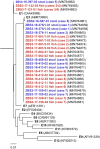First cross-border outbreak of foodborne botulism in the European Union associated with the consumption of commercial dried roach (Rutilus rutilus)
- PMID: 36684858
- PMCID: PMC9846170
- DOI: 10.3389/fpubh.2022.1039770
First cross-border outbreak of foodborne botulism in the European Union associated with the consumption of commercial dried roach (Rutilus rutilus)
Abstract
Botulism outbreaks due to commercial products are extremely rare in the European Union. Here we report on the first international outbreak of foodborne botulism caused by commercial salt-cured, dried roach (Rutilus rutilus). Between November and December 2016, an outbreak of six foodborne botulism type E cases from five unrelated households was documented in Germany and Spain. The outbreak involved persons of Russian and Kazakh backgrounds, all consumed unheated salt-cured, dried roach-a snack particularly favored in Easter-European countries. The implicated food batches had been distributed by an international wholesaler and were recalled from Europe-wide outlets of a supermarket chain and other independent retailers. Of interest, and very unlike to other foodborne disease outbreaks which usually involves a single strain or virus variant, different Clostridium botulinum strains and toxin variants could be identified even from a single patient's sample. Foodborne botulism is a rare but potentially life-threatening disease and almost exclusively involves home-made or artisan products and thus, outbreaks are limited to individual or few cases. As a consequence, international outbreaks are the absolute exception and this is the first one within the European Union. Additional cases were likely prevented by a broad product recall, underscoring the importance of timely public health action. Challenges and difficulties on the diagnostic and epidemiological level encountered in the outbreak are highlighted.
Keywords: Clostridium botulinum type E; Rutilus rutilus; commercial dried roach; fish; foodborne botulism; outbreak investigation.
Copyright © 2023 Hendrickx, Varela Martínez, Contzen, Wagner-Wiening, Janke, Hernando Jiménez, Massing, Pichler, Tichaczek-Dischinger, Burckhardt, Stark, Katz, Jurke, Thole, Carbó, del Pobil Ferré, Nieto, Zamora, Sisó, Pallares García, Valdezate, Schaade, Worbs, Dorner, Frank and Dorner.
Conflict of interest statement
The authors declare that the research was conducted in the absence of any commercial or financial relationships that could be construed as a potential conflict of interest.
Figures


Similar articles
-
Outbreak of type E foodborne botulism linked to traditionally prepared salted fish in Ontario, Canada.Foodborne Pathog Dis. 2014 Oct;11(10):830-4. doi: 10.1089/fpd.2014.1783. Epub 2014 Sep 4. Foodborne Pathog Dis. 2014. PMID: 25188279
-
National outbreak of type a foodborne botulism associated with a widely distributed commercially canned hot dog chili sauce.Clin Infect Dis. 2013 Feb;56(3):376-82. doi: 10.1093/cid/cis901. Epub 2012 Oct 24. Clin Infect Dis. 2013. PMID: 23097586 Free PMC article.
-
Rapid detection of foodborne botulism outbreaks facilitated by epidemiological linking of cases: implications for food defense and public health response.Foodborne Pathog Dis. 2012 Feb;9(2):150-5. doi: 10.1089/fpd.2011.0971. Foodborne Pathog Dis. 2012. PMID: 22315952
-
Foodborne Botulism, Canada, 2006-20211.Emerg Infect Dis. 2023 Sep;29(9):1730-7. doi: 10.3201/eid2909.230409. Emerg Infect Dis. 2023. PMID: 37610295 Free PMC article. Review.
-
The Epidemiology of Foodborne Botulism Outbreaks: A Systematic Review.Clin Infect Dis. 2017 Dec 27;66(suppl_1):S73-S81. doi: 10.1093/cid/cix846. Clin Infect Dis. 2017. PMID: 29293934
Cited by
-
A large travel-associated outbreak of iatrogenic botulism in four European countries following intragastric botulinum neurotoxin injections for weight reduction, Türkiye, February to March 2023.Euro Surveill. 2023 Jun;28(23):2300203. doi: 10.2807/1560-7917.ES.2023.28.23.2300203. Euro Surveill. 2023. PMID: 37289431 Free PMC article.
-
Conflicting Clinical Presentation of Infection with Clostridium botulinum and Clostridium perfringens in a 5-Month-Old Infant.J Pediatr Clin Pract. 2025 Jan 23;15:200140. doi: 10.1016/j.jpedcp.2025.200140. eCollection 2025 Mar. J Pediatr Clin Pract. 2025. PMID: 39990774 Free PMC article.
-
Exploring the genetic background of the botulism neurotoxin BoNT/B2 in Spain.Microbiol Spectr. 2023 Sep 26;11(5):e0238023. doi: 10.1128/spectrum.02380-23. Online ahead of print. Microbiol Spectr. 2023. PMID: 37750689 Free PMC article.
-
Navigating the Complexities Involving the Identification of Botulinum Neurotoxins (BoNTs) and the Taxonomy of BoNT-Producing Clostridia.Toxins (Basel). 2023 Sep 3;15(9):545. doi: 10.3390/toxins15090545. Toxins (Basel). 2023. PMID: 37755971 Free PMC article. Review.
-
Botulism in fish: a review.J Vet Diagn Invest. 2024 May;36(3):312-318. doi: 10.1177/10406387241236725. Epub 2024 Mar 11. J Vet Diagn Invest. 2024. PMID: 38465871 Free PMC article. Review.
References
-
- European Centre for Disease Prevention and Control . Surveillance Atlas of Infectious Diseases Stockholm, Sweden: European Union. (2022). Available online at: http://atlas.ecdc.europa.eu/public/index.aspx?Dataset=27&HealthTopic=7 (accessed May 05, 2022).
Publication types
MeSH terms
Substances
LinkOut - more resources
Full Text Sources
Medical
Research Materials

